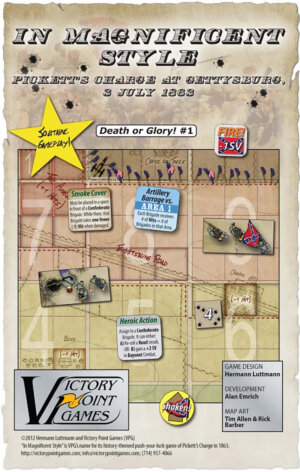
Publisher: Victory Point Games
Designer: Hermann Luttmann
Artist: Tim Allen
Year: 2012
Genre: Light, push your luck ACW wargame
Players: Solitaire, with optional two player rules
Ages: 12+
Playing Time: 60 Minutes
MSRP: $24.95
Hermann Luttmann once again shows his versatility as a game designer with In Magnificent Style (IMS) as the title is nothing like his three previous VPG efforts – The States of Siege game Dawn of the Zeds, the miniatures-like Gettysburg: The Wheatfield, and the baseball slugfest High and Tight. This first entry in Victory Point Games’ Death or Glory! series is a quick playing look at the main focus of the third day of battle surrounding the small town of Gettysburg on July 3rd, 1963. I say look, as opposed to simulation, because the game plays fast and loose with an eye toward creating narrative and a instilling a sense of the incredible odds facing George Pickett’s division rather than providing die hard grognard realism.
This isn’t to say In Magnificent Style isn’t a hell of a lot of fun though!
IMS can be best described as a push your luck sort of game: Will you push forward hard with your Confederate advance to seize the day knowing full well each additional effort could end in dire consequences? Great risk can play out into greater reward while, on the flip side, could also end in crippling setbacks leading to a devastating defeat.
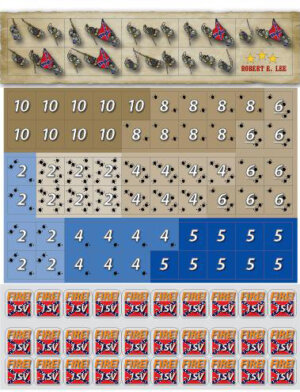
Facing you at the beginning of the game is the same situation Pickett looked out upon that sweltering July Pennsylvania afternoon. How can you cover over a mile of open ground to engage the well defended Union position on Cemetery Ridge while maintaining unit cohesion in order to put up a fight once you reach that position? Time is of the essence and the God of War doesn’t reward the meek as you only have five turns in which to reach and, hopefully, inflict heavy losses on the Federals.
The Confederate forces at your command consist of nine brigades which you’ll individually maneuver across the map in hopes of attaining the Union position. Once you activate a brigade you begin to move toward the Union lines. To begin movement, you’ll roll two different colored D6 for each brigade and cross reference each on a movement chart which will indicate if the brigade advances, takes fire, retreats, or is routed. Most rolls will indicate some forward momentum and you can choose to keep rolling for each brigade until you decide it’s best to stop or receive too much heavy enemy fire, a retreat, or rout. Each brigade has a rally marker which begins the turn in the same square as the unit. As you continue to roll for movement, the rally chit stays in place until that brigade chooses to end its turn when the rally marker can then be placed in the same square as the brigade. Various chart results can also lead to the particular brigade taking damage determined by the current distance from the chit as well. Obviously, the further away the brigade is from the chit, the worse it will be for taking damage or receiving a rout result. This is where much of the “push your luck” element comes into play as you need to decide just how far you’ll drive your troops forward until you feel the time is right to stop and regroup.
Throughout this process you may find your activated brigade taking hits (each begins with a strength value of ten), bringing about Union or Confederate events, or even finally entering into close quarters fighting if the Union line is reached. Once the entire process is completed for one brigade it’s on to the next.
Fire is resolved in an interesting way as the Rebels and Yankees don’t have a designated combat phase each turn. Union attacks take place through results on the movement chart as well as the blue side of the event chits. These effects are applied immediately as they take place. At the beginning of each turn, after the first, a number of Union event chits are also drawn as indicated on the map and resolved normally.
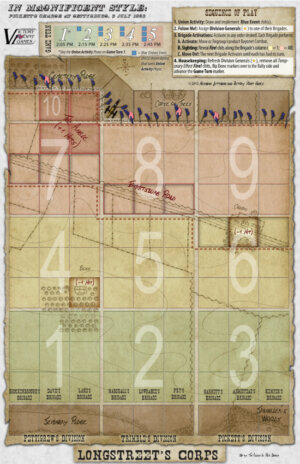
If a Confederate brigade reaches the Union position, the forces engage in bayonet combat. The strengths of both sides are calculated, along with additional modifiers, in order to determine any losses for both sides. If both sides still have unit strength left at the end of the combat, they’ll continue to duke it out on the next turn. If the Confederates are eliminated the brigade is removed from play but if they are victorious that brigade will be counted toward victory points at the end of the game.
The turn process is completed by each brigade, in the order of your choosing, until all have taken their activations and at the time the turn ends with a short housekeeping phase. Then it’s on to the next turn until all five turns have been completed.
As with most VPG titles events have a huge impact on the game and, although they are represented by counters instead of cards, this events can be the make or break of Pickett’s Charge. As the game progresses the Union will draw more events to begin the turn and the more you roll the dice the better the chances Billy Yank will reveal even more nasty defenses and counter attacks against your Johnny Rebs. Some of these can be random obstacles put in your path, artillery attacks against units in a particular zone, generals being hit by fire, and more. Of course, continuing to roll the bones also provides you a chance to score Confederate events as well. These events could be random fire chits to place on the enemy, reinforcements, heroic actions, and other goodies to make your life easier. Or at least easier until you pick up the dice for your next roll…
Generals also come into play for the rebels and three are provided for each of the divisions: Pettigrew, Trimble and Pickett. Generals can only be attached to a brigade under their command and can provide the ability to do one of a few special actions each turn but the most important is no doubt the chance to reroll a bad movement result. Generals become permanently attached to a brigade once the unit has reached the Union positions and if the Confederate unit is ever eliminated (regardless if the commander is permanently attached or not) the general is removed from play as well.
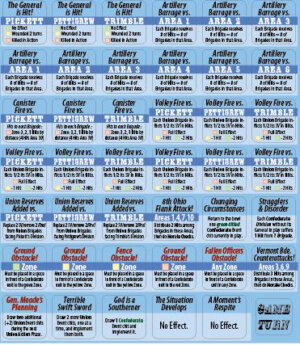
On a side note, although the game is designed for solitaire play there are some optional two player rules but I can’t really see someone taking the reins of the Union since there really isn’t a whole lot they can do outside of determining exactly how random Union events are applied. Then again, if you know a gamer who has to win all the time or runs a role playing game which always seems like it’s the characters against the GM, they might be an excellent choice to don Winfield Scott Hancock’s boots…
All in all In Magnificent Style is a fun game tackling a rather “ungamable” historical situation. Victory Point Games has a nice reputation for making against all odds sorts of simulations with the States of Siege line but I’d say the company would have been really hard pressed to turn the third day at Gettysburg into a SoS title; there was just too much stacked against Pickett and his Confederates during that fateful hour on that fateful day.
I’ve mentioned a few times IMS is a “push your luck” sort of game and that might be a drawback for gamers who don’t like a lot of randomness on their gaming tables. This title is practically all luck, from your die rolls to the event chits so even pulling off a stalemate is a kind of win given what the player is going to face. I could see playing this could be irritating for a few people out there.
Thankfully those sorts of gamers don’t usually frequent this site so, for the rest of us, In Magnificent Style is a really good game. Not perfect but a really good game none the less. The mechanic of the Fire chit draw, and placing them back in a pile once used, is a little awkward as you’ll need to mix them up a lot and you may subconsciously make note of where a miss chit is located. This isn’t an issue with the events because each displays both a Union and Confederate event. The role of luck in the game can really snatch any possibility of victory from your grasp in an instant and this can lead to a little frustration. Of course, this isn’t a huge issue because in life there’s a lot of randomness and never more so than on a battlefield (especially one 150 years ago) where fortunes change in the blink of an eye and you know what hits the fan at every turn. Sure, in IMS, the odds are crazy stacked against you but the game plays quick enough and only takes a few minutes to set up so every disastrous defeat can be put behind you while you prepare for yet another round in search of Death or Glory!
An advantage that (luckily for our nation) Robert E. Lee, James Longstreet, George Pickett, and the rest of their Confederate compatriots did not have available to them in those fields and forests surrounding the little town of Gettysburg…
- Broken Weave for 5E is Out in PDF - Apr 19, 2024
- Score Big Savings with the Ars Magica 5E Bundle of Holding - Apr 19, 2024
- Mark Herman’s For the People 25th Anniversary Edition is Marching Into Stores - Apr 19, 2024





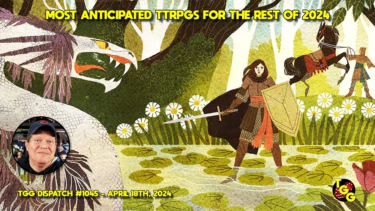
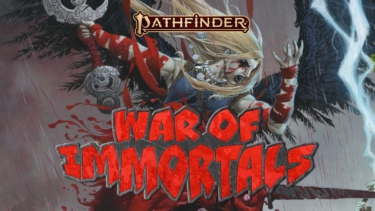
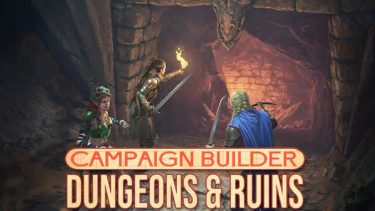



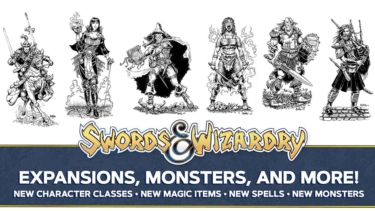
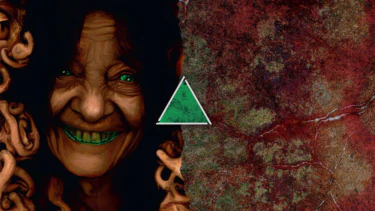

3 Comments
Thanks once again for a wonderful review, Jeff! Alan Emrich has labeled my game design philosophy as “Chaos Management Theory” and I not only accept that sobriquet, but embrace it. The more one reads military history the more one realizes that much of what happened during the turmoil of battle was pure luck and happenstance. Commanders could do their best to minimize chance, but could never remove it as a major factor. So what better situations to apply this theory to than with the near-suicidal frontal assaults of history! These battles are at the extreme end of “sh*t happens, deal with it” and thus are the focus of the Death or Glory system. And yes, if you don’t like being beaten down by the system once in a while through no fault of your own, then you won’t like this game. But so far we have received a number of game proposals using this system – the Somme, von Bredow’s Deathride at Mars-la-Tour, the Charge of the Light Brigade, Alligator Creek on Guadalcanal -and my next one will probably be Omaha Beach. So it look slike there’s a strong future for this series. Thanks again for an insightful review. As I’ve said before, I appreciate your honesty and the fact that you “get” what the intention of a design is. Hermann
Hey Jeff,
I note that you rate this game as an 8.8. Shouldn’t it then, feature on your Top Rated Games list, on the website’s rh column?
Just about to put an order in for this…..with a rebel yell!
Keep up the fine effort for gaming and greater glory, sir!
Greg
Thanks for the catch Greg! Just one of those things that slipped through the cracks. I’m in the midst of editing some video but I’ll make sure the top rated games gets updated before the night is out!